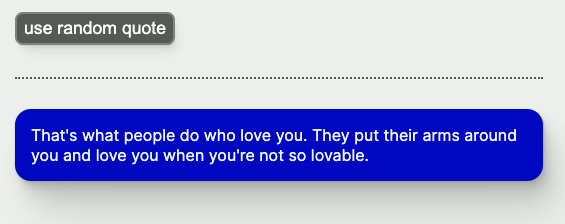To prepare for this series, you’ll need to fork or clone the scaffolding repository . Take a look at the README for instructions to install and run the app.
Series context
Before this series
- The previous series, React Components , built low-level components (
Button,CardandSpinner) for this application.
This series
- This series (Next.js Data Fetching) will build an app that fetches and displays a random quote.
- At the end of this series, the application will display a random quote from the server. Here’s an example:

After this series
- The next series ( AI Style Generator ) will use the OpenAI Node SDK to style the quote with a font and color appropriate to the quote text.
Workshop goal
By the end of this workshop you should have an endpoint on the server that serves a random quotation.
Notes
- See src/helpers/random-quotes.ts for a function to return a random quote.
- The quotations in data/quotes.ts were assembled from two Kaggle datasets . The quotes do not necessarily reflect the views of this instructor. 😅
- You may notice grammatical errors and/or unnecessarily gendered language in some the quotes. We’ll take care of these issues in the next workshop series (AI Style Generator).
Hints
Hint 1
Create a Next.js route handler at src/app/api/get-quote-styles/route.ts (a note about the directory name: for this series we’re just getting the quote; the style will come in the next series).Hint 2
The file should export a GET function that runs thegetRandomQuote function from src/helpers/random-quotes.ts, and returns JSON (something like '{"quote": <random quote>}' where <random-quote> is the quotation returned by getRandomQuote).Hint 3
To test your route handler:- Run
npm run devfrom the top level of the app in the terminal. - Access http://localhost:3000/api/get-quote-styles to hit the endpoint and see the result in your browser. Since you’re retrieving a random quote, the response should be different every time you refresh this page.
Hint 4
If your endpoint isn’t functioning the way you think it should be, there are two places to check for errors:- the browser JavaScript console (for example, in Chrome )
- the command-line where the server is running (where you ran
npm run devto start the server).
Resources
- Next.js route handlers